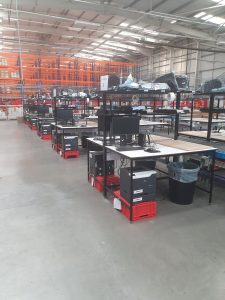Your basket is currently empty!

Consumers are demanding that companies that supply their goods use more sustainable practices. There are several ways that warehouses are reducing their environmental impact.
Warehouses use large amounts of energy for heating. Heated anti-fatigue mats warm workers directly and allow the surrounding air to be kept at lower temperatures. They are inexpensive to run, saving money and reducing the carbon impact.
Warehouses also need to optimise their use of space. One way to do this is to have custom-sized cartons that exactly fit items, prevent empty space and lower pallet heights. If the cartons are reused, it lowers waste and costs.
There is an increasing demand for sustainable packing that is 100% recyclable and biodegradable, which breaks down in landfills without leaving plastic waste. Packaging chips made from maize-based starch protect fragile goods in transit and, unlike polystyrene or plastic bubble wrap, are recyclable and biodegradable.
Shelving, trolleys, packing tables and other equipment from a warehouse equipment supplier are made from tubular steel. Steel manufacturers are switching to greener steel made using renewable energy and containing recycled steel.
Most warehouses are not carbon-neutral, but there is a trend in that direction. For instance, L’Oréal says that by the end of 2025, all its sites will be carbon-neutral and use 100% renewable energy. The company is encouraging their suppliers to also reduce carbon emissions.
Energy-efficient warehouses are less costly to run, and a commitment to sustainable practices not only reduces their environmental impact, but also enhances the brand’s image.
You may also interested in:

New report highlights limitations of automating the warehouse
A new report by Prological on the future of warehouses examines the issue of automation. It notes that
How repairing damaged warehouse equipment beats replacing entirely
A White Paper by Southgate Global has detailed how repairing warehouse equipment instead of
